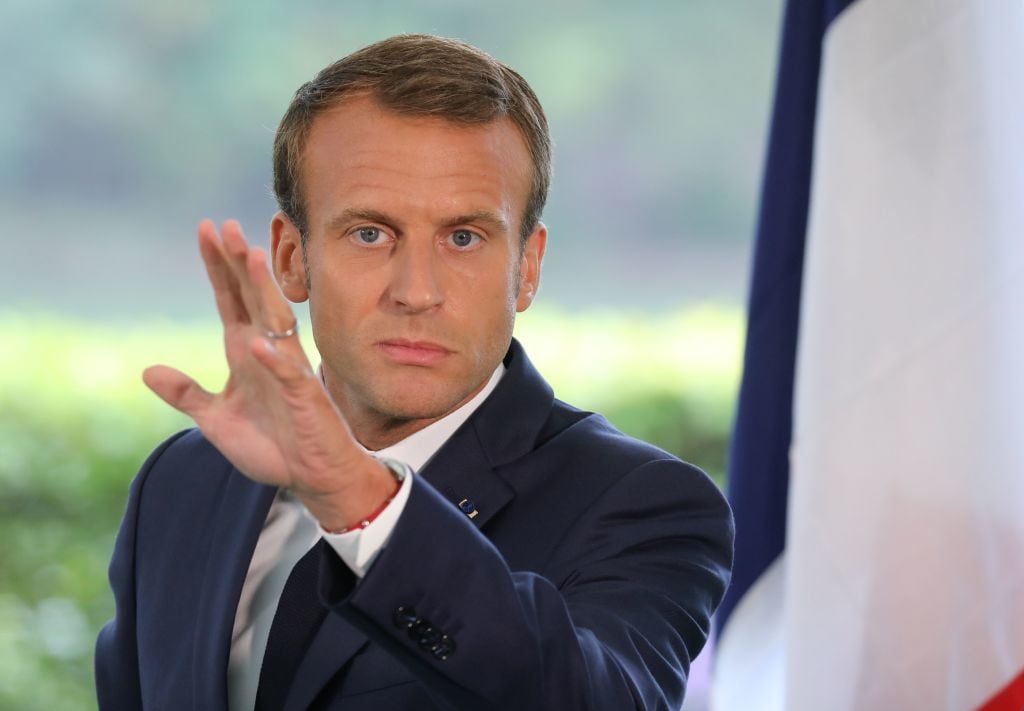Opinion
The Gray Market: Why We Need to Bust Old Myths About Artist-Brand Collaborations (and Other Insights)
Our columnist on why corporate patronage is more complicated than ever before for artists, institutions, and governments alike.

Our columnist on why corporate patronage is more complicated than ever before for artists, institutions, and governments alike.

Tim Schneider

Every Monday morning, artnet News brings you The Gray Market. The column decodes important stories from the previous week—and offers unparalleled insight into the inner workings of the art industry in the process.
This week, stories about the messy realities of corporate arts cash…
On Monday, Jacob Gallagher at the Wall Street Journal addressed the question of whether the fashion industry has taken its licensing of art “too far.” And in the course of investigating the proliferation of old-hat artist-brand collaborations like Andy Warhol socks, Jean-Michel Basquiat button-ups, and Keith Haring boxers, one of the most enduring ghost stories of the art market appears again, courtesy of Gallagher’s conversations with artist and visiting Pratt professor Beverly Semmes:
Still, there is a fundamental reason why the work of Basquiat, Warhol, and Haring in particular is seen so frequently on everything from hoodies to boxer briefs to a ceramic key tray: They’re deceased. Because of that, as Ms. Semmes noted, there’s less danger of diluting their reputation, something a living artist would fear.
With all due respect to Semmes and Gallagher, I have been hearing people warn artists and others about the catastrophic reputation damage caused by working with brands since I started working in the industry in 2005. And to be fair, I’m certain I took to the campfire and spooked people about the same peril at points between then and now.
But 13 years later, here’s what I’m still waiting for when it comes to the threat of artists being exiled from good standing largely, if not solely, because of corporate collaborations: a single real-world example of this happening.
Why do people want to advertise that, the moment an artist accepts a commission from Chanel or designs a product for Nike, it triggers a trap door that dumps them into some centipede-infested, subterranean art jail? It sounds great to purists and it benefits plenty of leverage-seeking or overprotective gallerists.
However, like the notions that people always marry for love, professional success is solely based on merit, and “what goes around comes around,” this is a spit-shined token of idealism with little actual currency in the complex world we call home.
To me, there are a couple of fundamental flaws in the idea in 2018. First, it’s dubious to act as if all living artists are the same. As I wrote a while back about gaudy, blatant branded-retail plays like Jeff Koons and Takashi Murakami’s Louis Vuitton handbag lines…
The reality is that the select few artists capable of successfully straddling merchandising and the upper-echelon art market are the only ones who get invited to spread-eagle themselves in the first place. It’s not as if Chanel is chasing after Paul McCarthy in a Brinks truck to try to get him to design luxury bags that look like freshly harvested internal organs. The partnership would be equally counterproductive for both parties, because the aesthetic and the clientele simply wouldn’t match.
In other words, some artists make work that actually fits really well with glitzy branded merch! And even for those who don’t, there’s a second, even more forceful reality check in store…

Cao Fei, Derivation Blurs the Virtual and Physical Worlds (2017). Courtesy of Cao Fei and Vitamin Creative Space.
As refreshingly detailed by Samantha Culp in The Atlantic this week, the ecosystem of art and commerce has evolved in recent years to upend the old-school myth that all corporate collaborations are reputation-devouring wraiths.
Culp shows that change has taken place on both sides of the patronage relationship: Many promising younger artists are less puritanical about their interactions with the big bad market than their predecessors, and many corporations are now interested in freeing artists to do much more than pump out in-your-face products—a shift that opens up opportunities for more than just omnipresent superstars.
One especially telling example comes from Culp’s time as a studio manager for Cao Fei in 2009, when Hermès approached the rising star about a partnership. Culp writes:
I knew Cao to be uncompromising in all aspects of her vision, so I was initially surprised that she’d consider the project. Then she explained that the brand was giving her carte blanche—she just had to put its logo in the end credits. As she saw it, Hermès was essentially paying her to make a video she would have made anyway—and, in paying her a significant fee, would also fund another more experimental project she wanted to do.
Now, Culp points out that this example lives at a favorable extreme of the pro-artist spectrum. She warns about the numerous pitfalls of some other brand collaborations, including (as relayed by Amalia Ulman from firsthand experience) the prospect that even massive corporations might just axe your commission and compensation at the last minute.
But looming over this entire discussion are the sobering realities of the 21st-century world economy—and inside it, the art market. Globalization, technology, and regulatory/tax policy have created a winner-take-all nightmare for the working and middle classes outside of developing countries. Federal funding of the arts, both inside and outside the US, has been shriveling up like a vegetable permanently trapped in an oven grate. Studio space and living expenses in arts hubs, even longtime safe haven Berlin, have become prohibitively scarce and expensive. Setting aside the special hell of MFA costs, student debt has become such an unholy terror that we Americans now have a game show premised on the remote hope of repaying it. The world decided that art is an asset class, but almost none of the resale profits need to cycle back to the artists themselves.
And people, particularly other stakeholders in the industry, still think we should clutch our pearls over artists occasionally working with brands?
To argue that corporate patronage is inherently unhealthy for artists today, you have to pretend that patronage from private collectors, institutions, and governments is a consistent model of ethics and fairness. In 2018, little could be further from the truth.
I’m not saying we shouldn’t pay close attention to how branded cash will impact the arts. I’m just saying that it deserves no more or less scrutiny than any traditional funding source. And the sooner we banish the bogeyman of the corporate sell-out, the sooner we can face up to the much scarier threats posed by systemic dysfunction in both the art world and the wider one.

Visitors jostling to get a pic of da Vinci’s Mona Lisa at the Louvre in France. Photo via Flickr.
Finally this week, on Wednesday, my colleague Naomi Rea reported that French lawmakers are considering saying au revoir to the so-called “Aillagon Law,” a 15-year-old wrinkle in the tax code that has helped quadruple annual nonprofit arts funding since its implementation. The act allows corporations to deduct up to 60 percent of their annual donations to “general interest bodies”—basically, organizations pursuing a public good, such as health, education, or humanitarian causes—and charities, with the cap set at 0.5 percent of annual turnover.
Defenders of the policy, including multimillion-euro recipients like the Louvre, the Palace of Versailles, and the Pompidou Center, argue that, in Rea’s words, “almost all [French] public museums, dance companies, orchestras, and historic sites depend on corporate sponsorship and private donations to survive.”
Critics, on the other hand, argue that the Aillagon Law shifts responsibility for about €930 million, or over $1 billion, in annual tax revenue from corporations to average citizens. And I’d also add that France is still one of the world’s most robust state supporters of the arts by more than a couple of baguette lengths. Its 2017 budget included €2.9 billion (about $3.2 billion) in spending on culture, and French lawmakers matched that same number again this year, per Statista.com.
In comparison, the combined 2019 federal budget for the US’s National Endowments for the Arts and Humanities totals $310 million. As an American, this feels about as pathetic as proposing to your longtime significant other with a piece of candy jewelry, but facts are facts (at least in this column).
Now, there is an argument that corporations might actually donate just as much as, or even more than, the Aillagon Law’s 0.5-percent-of-annual-turnover cap if you take away their quid pro quo incentive to do so. Rea relays that Sorbonne associate professor Jean-Michel Tobelem pursued some version of it in Le Monde, but I don’t know his route, because Google Translate couldn’t even get through the pre-paywall section without bracketing a bunch of grammatical gibberish around the suggestion that corporations “sometimes seek to benefit from butter and the money of the butter.”
From my perspective, though, this argument doesn’t hinge on innate human generosity, as I’ve heard libertarians contend. It hinges on corporate self-awareness and self-preservation.

French President Emmanuel Macron. Photo by Ludovic Marin/AFP/Getty Images.
President Emmanuel Macron—dubbed “president of the rich” by his detractors— has been pushing an aggressively pro-business agenda since he took office. Ironically, the Aillagon Law is in jeopardy partly because the National Assembly wants to find roughly €1 billion to implement even more reforms to benefit businesses.
In 2018, big firms around the globe are building towering money stacks at unprecedented rates, and they know all too well that (seemingly) substantial giving is a terrific smokescreen for how perversely favorable to their interests the world has become.
As Anand Giridharadas, author of Winners Take All: The Elite Charade of Changing the World, wrote in The New Yorker about major banks ramping up public philanthropy after their predatory behavior in, and minimal repercussions from, the Great Recession, “A little bit of generosity could be put forward as a plausible substitute for justice. Giving in millions has a way of erasing harm done in billions.”
So if you create (or preserve) a law that corporations can only benefit by giving X amount, it incentivizes them to give exactly X amount, then throw up their hands and say, “It’s the most we could do!” If you remove the benefits and the limit attached to those benefits, then corporations have to ask: How much do we have to give to prevent people from looking at how much more we’re getting? And without an anchor amount written into the tax code, there’s a chance that they go even bigger.
Would this happen if France blew up the Aillagon Law? I don’t know. But the heated debate over the act’s merits reveals that corporate patronage will still be a major arts funding source either way. So whether the recipients are artists or institutions, if you think branded money is dirty, you’d better get comfortable in the muck.
That’s all for this week. ‘Til next time, remember: No one gets out of this completely clean.